Date : November 4 - 5, 2010
Notice: Yamaguchi Press Tour (November 4-5, 2010)
post date : 2013.08.22
~Explore the birthplace of the Meiji Restoration,
where the driving force to launch a new era originated:
Spirit for modernization on their own in the Bakumatsu period continues~
 On Sunday nights recently people in Japan have enjoyed watching the NHK TV serial drama "Ryoma-den" which highlights historic people and events in the Bakumatsu Ishin period, the times of the late Tokugawa shogunate and the Meiji Restoration. Why? Presumably because many of the viewers see a resemblance to the current situation of Japan which has been suffering from a sense of stagnation since the “lost decades”, and wonder whether they can revitalize it. The hero, Ryoma Sakamoto, was a famous leader of the movement to overthrow the Shogunate and embark on the Meiji Restoration; he was also a mediator of the Choshu (now Yamaguchi Pref.) - Satsuma (now Kagoshima Pref.) alliance.
On Sunday nights recently people in Japan have enjoyed watching the NHK TV serial drama "Ryoma-den" which highlights historic people and events in the Bakumatsu Ishin period, the times of the late Tokugawa shogunate and the Meiji Restoration. Why? Presumably because many of the viewers see a resemblance to the current situation of Japan which has been suffering from a sense of stagnation since the “lost decades”, and wonder whether they can revitalize it. The hero, Ryoma Sakamoto, was a famous leader of the movement to overthrow the Shogunate and embark on the Meiji Restoration; he was also a mediator of the Choshu (now Yamaguchi Pref.) - Satsuma (now Kagoshima Pref.) alliance.
However, the story of the young Choshu men who also played important roles in modernizing the country at the time is also intriguing. Having a vision for the future of Japan, five young men went under cover to the United Kingdom in the late Tokugawa period: Hirobumi Ito (the first Prime Minister), Kaoru Inoue (the first Minister of Foreign Affairs), Masaru Inoue (built Japan’s first railroad), Kinsuke Endo (promoted the original mint), Yozo Yamao (promoted shipbuilding and education for the handicapped). The "Choshu Five" - a British newspaper named them in those days - returned home with valuable information that would help modernize their country.
The political genealogy originating from the Meiji government continues unbroken in Yamaguchi Prefecture where nine Prime Ministers, the largest number in the country, including the current premier Naoto Kan, were born. And the Choshu Five’s challenge of building a modern country has been taken up by Yamaguchi’s manufacturing industry.
The tour will visit Hagi City, which is called the place of the Meiji Restoration’s conception and currently aims at getting the world heritage registration of its modern industrial heritage sites, and will examine how the Hagi (Choshu) clan made trial and error efforts to modernize themselves during the last days of the Tokugawa shogunate. In addition, it will visit local small-and-medium-sized firms which extend their field from Yamaguchi to the world with a will to tackle global issues including environment, energy, and the population aging.
<Yamaguchi Prefecture Homepage>
1. Yamashita Kogyosho, Co., Ltd (Kudamatsu City)
~From “super-express train” to “supersonic airplane” – one-hammer artisans break through the times and change the times~
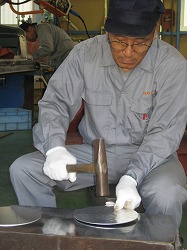 Located in Kudamatsu, an industrial city in the east part of Yamaguchi, facing the Seto Inland-sea National Park, Yamashita Kogyosho is a metal sheet processing factory with 35 employees. In 1964 when Asia’s first Olympic Games were held in Tokyo, the Shinkansen, called "the dream super-express train" in those days, debuted on October 1 and the very first train of the 0 Series "Hikari 1" departed from Tokyo Station. The face of that particular Shinkansen, with the elongated “forehead” at the front, was produced by the craftsmen of this company led by its founder Kiyoto Yamashita, currently Executive Consultant (72 years old), using only one kind of hammer. Since then the company has engaged in the production of most major models of the Shinkansen, from the 0 to the 700 Series, the current main type for Tokaido-Sanyo Shinkansen, and delivered more than 330 cars to Hitachi, Ltd.‘s Kasado Office nearby. It has also worked on express trains as well as monorails and experimental cars for the MAGLEV train, and receives orders for train cars from Taiwan and China.
Located in Kudamatsu, an industrial city in the east part of Yamaguchi, facing the Seto Inland-sea National Park, Yamashita Kogyosho is a metal sheet processing factory with 35 employees. In 1964 when Asia’s first Olympic Games were held in Tokyo, the Shinkansen, called "the dream super-express train" in those days, debuted on October 1 and the very first train of the 0 Series "Hikari 1" departed from Tokyo Station. The face of that particular Shinkansen, with the elongated “forehead” at the front, was produced by the craftsmen of this company led by its founder Kiyoto Yamashita, currently Executive Consultant (72 years old), using only one kind of hammer. Since then the company has engaged in the production of most major models of the Shinkansen, from the 0 to the 700 Series, the current main type for Tokaido-Sanyo Shinkansen, and delivered more than 330 cars to Hitachi, Ltd.‘s Kasado Office nearby. It has also worked on express trains as well as monorails and experimental cars for the MAGLEV train, and receives orders for train cars from Taiwan and China.
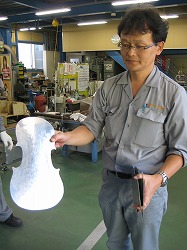
Earlier this year the company made full use of this original "sheet metal beating technique", which is to mold an elegant three-dimensional curved surface with one hammer, and created a cello from aluminum sheeting as well as a magnesium alloy violin, whose sound is comparable to that of the orthodox wooden instrument.
At present, participating in the joint development program for "the next generation supersonic passenger plane", the company invented a die to produce the main wing of the aircraft, together with the Japan Aerospace Exploration Agency (JAXA). “In order to pass on the high skills and techniques of our craftsmen to the next generation, we aggressively move into different fields", says the second-generation President Tatsuto Yamashita (45 years old).
2.Choshu Industry (Sanyo-Onoda City)
~A genuine R&D-driven manufacturer with innovative technology in cutting-edge fields such as semiconductor manufacturing and solar energy generation~
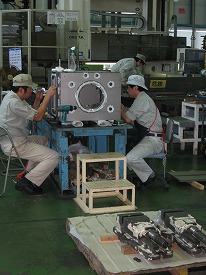 Founded in 1980, Choshu Industry started manufacturing and selling residential equipment and systems. Its first product, a solar hot water heater, arrived on the market and was followed by a series of domestic products including bath heaters, hot water systems, and solar energy systems. In 1985, the company extended its business to the cutting edge field by setting up a technical tie-up agreement with a leading maker of semiconductor production devices. At the time, selected six employees (name them “Choshu Six” ?) were sent to work at a supplier of semiconductor production devices and acquired its advanced technology in that field. With its strength in original and innovative technology development, the Choshu Industry’s hi-tech machines are appreciated and actively used in such countries as China, Taiwan, South Korea, and in the ASEAN.
Founded in 1980, Choshu Industry started manufacturing and selling residential equipment and systems. Its first product, a solar hot water heater, arrived on the market and was followed by a series of domestic products including bath heaters, hot water systems, and solar energy systems. In 1985, the company extended its business to the cutting edge field by setting up a technical tie-up agreement with a leading maker of semiconductor production devices. At the time, selected six employees (name them “Choshu Six” ?) were sent to work at a supplier of semiconductor production devices and acquired its advanced technology in that field. With its strength in original and innovative technology development, the Choshu Industry’s hi-tech machines are appreciated and actively used in such countries as China, Taiwan, South Korea, and in the ASEAN.
Aiming at realization of a “low carbon society", it is expanding its production and sales of panels for the domestic household PV system. In the meantime, it has joined the national project, namely “Green IT Project”, which is to develop a base technology for enlarging the organic EL (electroluminescence) display, the front-runner amongst next-generation thin-film display devices. Choshu Industry has some of the most advanced technology in the field of vacuum machinery through the design of the semiconductor production devices as well as the abundant know-how for the production of liquid crystal panel production devices.
3. TAKE Create Hagi, Co., Ltd. (Hagi City)
~Strong, flexible, and quick-growing - seizing upon tremendous potentials of “Take”, or bamboo, the ecologically sustainable material in collaboration with Finnish designers~
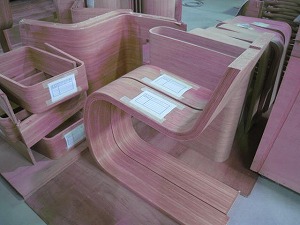 Utilizing the Hagi bamboo (moso-dake) of good quality, TAKE Create Hagi created high-end bamboo furniture with original and stylish design and was selected as one of the "300 SMEs of Vigorous Manufacture” promoted by METI’s Small and Medium Enterprises Agency three years after its foundation in 2006.
Utilizing the Hagi bamboo (moso-dake) of good quality, TAKE Create Hagi created high-end bamboo furniture with original and stylish design and was selected as one of the "300 SMEs of Vigorous Manufacture” promoted by METI’s Small and Medium Enterprises Agency three years after its foundation in 2006.
Yamaguchi prefecture has the fourth largest are of bamboo forest in Japan. In particular, there is a high quality banboo forest of 2,250 hectares in area in and around Hagi City, long known as a production center of bamboo. Characterized by its supreme resiliency and tenacity, the bamboo grown in Hagi, where it snows heavily in winter, was highly valued and used for a high quality Japanese bamboo blinds as well as for snowplow trains in Sapporo and Hakodate, Hokkaido.
Bamboo grows to full size from a shoot in two to three months, grows leaves then begins performing photosynthesis absorbing the same amount of CO2 as wood. It is indeed an ecological and sustainable material. Focusing on bamboo’s tremendous potential, the company developed techniques to enable it to produce furniture with a curvature in design, taking advantage of such characteristics of bamboo as flexibility and durability. Thanks to the collaboration between TAKE Create Hagi and young designers from Finland, bamboo, which used to be nuisance called "bamboo infestation", was reborn as innovative, humorous "magaru" furniture (means curve in Japanese).
4. Hagi Museum features: Modern Industrial Heritage in Hagi – Aiming at the World Heritage
 Hagi is a historic city dotted with many industrial heritage sites where the Hagi (Choshu) domain buckled down to the difficult task of casting cannons and building warships at the end of the Tokugawa shogunate period. Above all, the Hagi Reverberatory Furnace and others became Potential World Heritage Sites as component features of “The Modern Industrial Heritage Sites of Kyushu and Yamaguchi” and are now in the limelight.
Hagi is a historic city dotted with many industrial heritage sites where the Hagi (Choshu) domain buckled down to the difficult task of casting cannons and building warships at the end of the Tokugawa shogunate period. Above all, the Hagi Reverberatory Furnace and others became Potential World Heritage Sites as component features of “The Modern Industrial Heritage Sites of Kyushu and Yamaguchi” and are now in the limelight.
The reason why the Hagi domain tried a positive approach to science and technology was deeply related to the global dynamics in the middle of the 19th century. The leaders of the Choshu domain heard that China had completely defeated by the United Kingdom during the Opium Wars. Therefore, the Hagi domain felt threatened by the overwhelming weapons of Western powers, and was forced to recognize the necessity of reinforcing its coastal defenses.
On the other hand, the Hagi domain tried to promote not only production of war materials such as cannons, but also various fields of modern technology including medical science, glass working, photography, and steam engines. However, under the national isolation policy in the Edo period, they must have had far greater difficulty than we can imagine now in modernizing industry without depending on Europeans or Americans.
This special exhibition features the Hagi domain’s efforts at industrializing their own country through trial and error during the last days of the Tokugawa shogunate. The Hagi Museum opened in 2004, the year of the 400th anniversary of the start of the Hagi domain. Its many exhibits feature the three main characteristics of Hagi: “nature”; “castle town”; “Meiji Restoration” and the museum plays a core role in the “Hagi Machiju Hakubutsukan”, or a whole city that is museum, to be described below.
5. Tour of Hagi and Mayor Koji Nomura’s briefing: Machi-ju Hakubutsukan, or “whole town” museum, with the Potential World Heritage Sites
<Hagi City Website>
<Machiju Hakubutsukan Website>
 When you visit Hagi, you will see the features of an old castle town and also the layout of the town that was built during the 260-year Mori feudal administration period. It is the only city in Japan where you can still use old illustrated maps of the Edo period as they are: the ruins of the castle; Bukeyashiki, old samurai residences; Machiya, town houses; the old residences of the Meiji Restoration leaders; the Buddhist temple, and others are still there. They are all valuable cultural assets which represent Japan. The entire castle town remains as it is, and the citizens happily live in a place where the atmosphere of the early modern age remaining here and there, and they take good care of it.
When you visit Hagi, you will see the features of an old castle town and also the layout of the town that was built during the 260-year Mori feudal administration period. It is the only city in Japan where you can still use old illustrated maps of the Edo period as they are: the ruins of the castle; Bukeyashiki, old samurai residences; Machiya, town houses; the old residences of the Meiji Restoration leaders; the Buddhist temple, and others are still there. They are all valuable cultural assets which represent Japan. The entire castle town remains as it is, and the citizens happily live in a place where the atmosphere of the early modern age remaining here and there, and they take good care of it.
Thus, based on the idea of regarding the assets dotted all over the city as one museum, the City of Hagi, together with the citizens, is promoting the “Machiju Hakubutsukan” project, in order to pass on the treasures that exist only in Hagi to the next generation. The tour will visit the district where Horiuchi traditional architecture is preserved, the ruins of Hagi Castle, Hagi castle town, Daishoin Temple(photo on the right) and the following candidate sites for the World Heritage registration. Then Mayor Koji Nomura will wrap up the tour and talk with us. Mr. Nomura graduated from Kyoto University, worked with the Ministry of Finance (lastly served as Director, Examination and Criminal Investigation Department, National Tax Agency), and was elected as the Mayor of Hagi in 1993.
<Shokason Juku, private school presided over by Shoin Yoshida>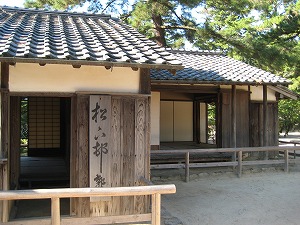 The tiny private school in a village, where thinker Shouin Yoshida, one of the most distinguished intellectuals of the closing days of the Tokugawa shogunate, educated young people. In 1854, Shoin failed to stow away and go to the United States from Izu Shimoda and was sent back home to Matsumoto Village, Hagi, where he was sentenced to house arrest although he was able to run the school.
The tiny private school in a village, where thinker Shouin Yoshida, one of the most distinguished intellectuals of the closing days of the Tokugawa shogunate, educated young people. In 1854, Shoin failed to stow away and go to the United States from Izu Shimoda and was sent back home to Matsumoto Village, Hagi, where he was sentenced to house arrest although he was able to run the school.
The boys who lived in the neighborhood gathered in the wooden tile-roofed one-storied hut of approximately 50 square meters in area, and as many as 30 pupils came to learn here. With his motto: have a high aim and accomplish it; carry out what you learn, Shoin educated the students in a way that respected the strengths/weaknesses of each student. He taught for only one year but from this small private school produced many talented people including Hirobumi Ito (the first Prime Minister) and Shinsaku Takasugi (in favor of overthrowing the Tokugawa shogunate and founder of Kiheitai, the Irregular Militia, raised by the Choshu domain) who became the driving force among the promoters of the Meiji Restoration.
He himself strongly criticized the weak-kneed diplomacy of the Shogunate and aggressively intended to live up to the political slogan “revere the Emperor, expel the barbarians”. Despite this, he was forcibly sent to Edo, executed at the age of 30 in the Ansei Purge of the Shogunate. Nine years later Japan witnessed the arrival of the new era called "Meiji", as Shoin’s students took over the will of their dead teacher and carried it out as he had taught them.
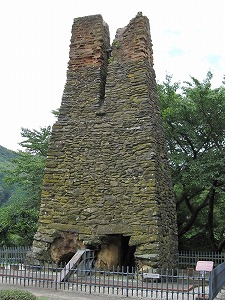 <Hagi Reverberatory Furnace>
<Hagi Reverberatory Furnace>
A reverberatory furnace was a metallurgical furnace invented in the West. It turned substandard iron into tough iron suitable for cannon. The Hagi reverberatory furnace was built as an experimental furnace to produce iron cannons of the Western style in 1856, but is thought to have failed in practice. You could say that this is real evidence of the trial and error as the Hagi domain made tremendous efforts at modernization. All that remains is the chimney part 11 meters in height, built of basalt and bricks. Currently the remains of another reverberatory furnace are located in Shizuoka Nirayama, and these two ruins are valuable monuments in the history of Japan’s industrial technology.
6. 2010 Japanese Traditional Crafts Festa in Hagi
Hagi City will host this annual grand exhibition of officially-designated traditional crafts of Japan between November 4 and 7. Yamaguchi Prefecture will be delighted to present the following three items: authentic “Akama ink stone” which is thought to have a history of 800 years; gorgeous “Ouchi Lacquer Ware” with a history dating back to the Muromachi period; “Hagi Ware (pottery and porcelain)” which was introduced in by potters from Korean Peninsula about 400 years ago and has long been admired in the world of tea ceremony. During the event, the Association of Traditional Craftsmen of Japan will have a showing of their works. Visitors will be able to enjoy not only the exhibition but also shopping and viewing craftsmen’s work on the spot.
※Foreign Press Center/Japan, Yamaguchi Prefecture, and Hagi City have co-organized this press tour. Tour participants bear part of the cost, but the purpose of the tour is not profit-making.
Tour itinerary and application details:
1. Date: November 4th to 5th, 2010
2. Qualification: Bearer of Gaimusho foreign press registration card
3. Expenses: 13,000 yen per person including transportation, meals, and accommodation
* FPCJ will later inform the participants of methods for payment, cancellation fee etc.
4. Participants: Limited to the first ten applicants on a first-come first-served basis.
(Only one reporter and one photographer from each company, but two participants from each TV team will be acceptable.)
5. FPCJ Contact: Ms. Koizumi and Ms. Yoshida (Tel: 03-3501-3405, 5070)
6. Remarks:
* The FPCJ, Yamaguchi Prefecture, and Hagi City will not be liable for any inconvenience, trouble or accident that might occur in the course of the tour.
**There are some restrictions on photographing and filming at the tour sites. Please follow the instructions of the officials on duty.



